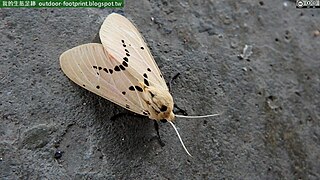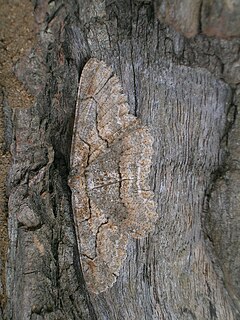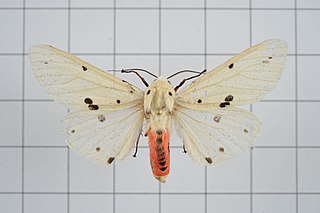
The buff ermine is a moth of the family Erebidae. It is sometimes placed in the genus Spilosoma. The species was first described by Johann Siegfried Hufnagel in 1766. It is found throughout the temperate belt of the Palearctic region south to northern Turkey, Georgia, Kazakhstan, southern Siberia, eastern Mongolia, Amur Region, China, Korea and Japan.

Minois dryas, the dryad, is a butterfly of the family Nymphalidae.

Spilarctia is a genus of moths in the family Erebidae. The genus was erected by Arthur Gardiner Butler in 1875.

Comostola is a genus of moths in the family Geometridae erected by Edward Meyrick in 1888. They are found primarily in Asia and Australia.

Hypomecis is a genus of moths in the family Geometridae first described by Jacob Hübner in 1821.

Ourapteryx is a genus of moths in the family Geometridae. The genus was erected by William Elford Leach in 1814.

Pachyerannis is a monotypic moth genus in the family Geometridae described by Inoue in 1982. Its only species, Pachyerannis obliquaria, first described by Victor Motschulsky in 1860, is known from Japan and the Russian Far East.

Scopula is a genus of moths in the family Geometridae described by Franz von Paula Schrank in 1802.

Eupithecia selinata is a moth of the family Geometridae. It is found from Japan through the Amur Region, Siberia, the Urals, Caucasus and Russia to western Europe and from southern Fennoscandia to the Alps.

Lymantria dispar japonica, commonly known as the Japanese gypsy moth, is a moth in the family Erebidae of Eurasian origin.
Spilarctia bisecta is a moth in the family Erebidae. It was described by John Henry Leech in 1889. It is found in China.
Spilarctia graminivora is a moth in the family Erebidae. It was described by Hiroshi Inoue in 1988. It is found in Japan and Taiwan.

Spilarctia alba is a moth in the family Erebidae. It was described by Otto Vasilievich Bremer and William Grey in 1853. It is found in China, Taiwan and Korea.
Spilarctia mona is a moth in the family Erebidae. It was described by Charles Swinhoe in 1885. It is found in southern India.
Spilarctia obliquizonata is a moth in the family Erebidae. It was described by Miyake in 1910. It is found in the Russian Far East and Japan.
Spilarctia tigrina is a moth in the family Erebidae. It was described by Frederic Moore in 1879. It is found in southern India.
Chrysoteuchia porcelanellus is a moth in the family Crambidae. It was described by Motschulsky in 1861. It is found in Russia and Japan.










